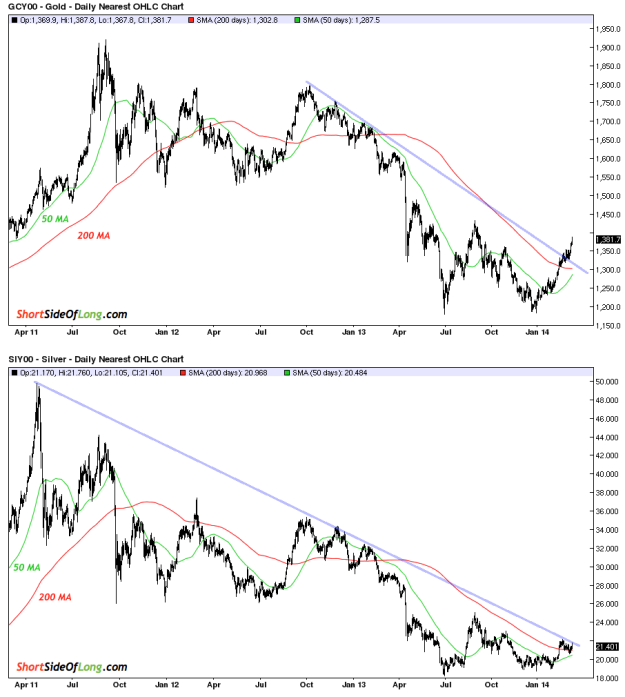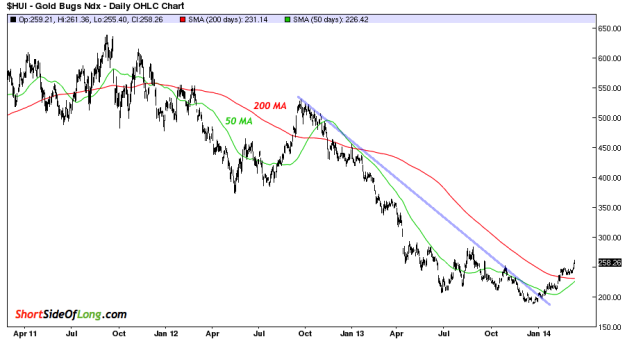Chart 1: Gold continues to lead Silver out of the recent December lows
The first chart shows the overall topping process and the unfolding bear market in both Gold and Silver. Let us remember that Gold peaked in early September 2011 around $1920 per ounce and has been in decline for over 2 years and 6 months. The price of Gold declined about 38% from peak to trough during that time frame. On the other hand, the bear market in Silver has been even more ravaging. Silver peaked in late April 2011 as it approached $50 per ounce and has been ind decline for almost 3 years now (1st of May 2014 will mark a full three year bear market period). From peak to trough, Silver declined by a staggering 63%.
Technically, both metals together with the Gold Miners (seen in the chart below) are now close to a so called “golden cross” signal, which everybody seems to be talking about. This signal occurs when the 50 day moving average crosses over the longer 200 day moving average. Technicians usually state that a signal like this hints at a new bull market trend, but its theory is always up for a discussion. One thing is true however, historically, this type of a signal works better for general equity markets. Predictability is not as good for the metals (or any commodity), especially during the 1980s and 1990s as almost all commodities were in a secular bear market.
Finally, investors should carefully watch Silver prices, as they continue to push against a three year bear market downtrend line. A breakout right here could be a positive outcome, with the super bear from 2011-14 possibly coming close to an end. On the other hand, a reversal here could signal more downside. While Silver always lags at the start of bull markets, the fact that it hasn’t yet broken out of its downtrend (unlike Gold and Gold Miners) could be seen as a sign for caution. Disclosure: nevertheless, I continue to hold Silver as a full position, with more than 88% of my NAV exposed on the long side towards the metal.
Chart 2: Gold Miners are now awfully close to a “golden cross” signal…
Finally, I leave you with a very interesting Precious Metals summary from Frank Holmes and US Global Investors:
- Sentiment: Gold posted a very strong week, rising $43.07 per ounce as Chinese macroeconomic data revived fears of a global slowdown, and geopolitical tensions brewed ahead of the scheduled Crimea referendum this weekend. Furthermore, and as shown on the chart above, the 50-day moving average closed less than $10 below the 200-day moving average, which implies that barring a gold collapse below $1,300 next week, we should see gold making a golden cross before the end of the week. Our analysis shows that, going back to 2000, a golden cross in gold is followed on average by a 50 percent rally lasting on average 15 months.
- Sentiment: A Royal Bank of Canada report shows similarities between the 2005 to 2008 gold price rally and the current gold price environment, which analysts believe could lead to a sustained gold price rally over the next 12 to 24 months. While still early in gold recovering from its lows, Chinese and emerging market gold demand combined with the absence of central bank selling both offset any ETF liquidations. Given the volumes seen in China recently, and the fact the Chinese market is not as price sensitive – thanks to high savings rates – Chinese demand on its own could replicate the 2005-08 ETF-driven gold rally.
- Sentiment: The instability in Ukraine, together with the China hard-landing fears, has not changed Goldman Sachs’ bearish view on gold. According to Jeffrey Currie, the bank’s head of commodities research, the weakness in the U.S. and the turmoil in Ukraine are not driving gold. Instead, the lower mining costs mean it is more probable that gold drops below $1,000. Marc Faber on the other hand believes the near tripling of the S&P 500 since the end of the bear market in 2009, together with heavy insider selling, high valuations, and extremely high corporate profits should make any investor consider the possibility that we may be at a top of the U.S. equity cycle.
- Demand: Gold ETFs appear to be back in fashion, as total known gold ETF holdings are now 870 thousand ounces higher since bottoming at 55.8 million ounces in mid-February. The ETF data comes as the situation in Ukraine reinforces gold’s safe haven status and the weak macroeconomic data coming from China highlight gold’s hedging properties amid a risk-off investing environment.
- Demand: The China Gold Association (CGA) said China’s gold demand may decline by 17 percent to 250 tonnes in the first quarter of 2014, from 300 tonnes in the first quarter of 2013. Despite this fact, CGA vice chairman Zhang Yongtao expects annual demand to remain strong at 1,176 tonnes, very close to the actual annual demand for 2013. According to HSBC Research, Mr. Zhang’s forecast indicates that China’s gold demand should be stronger for the rest of 2014 after the first quarter, when compared to the same period in 2013. This may indicate that China’s strong appetite for gold is likely to be sustained well into 2014.
-
Demand: A wave of weak economic data released by the Chinese government agencies this week helped propel gold higher as U.S. and Europe markets weighed the risk of a deceleration in Chinese economic growth. The weak data points released show the risk of Chinese physical gold and jewellery buyers to defer consumption to a later date. As a matter of fact, Chinese retail sales data showed growth of 11.8 percent, missing analysts’ estimates for a 13.5 percent increase. As a result, gold demand from China may be lower in the short term, or until the festive and marriage season starts later in the year.


